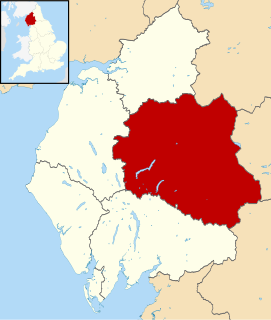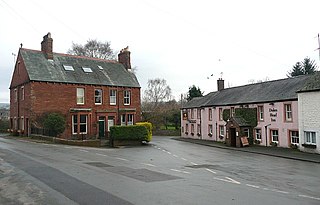
Henry Percy, 1st Earl of Northumberland, 4th Baron Percy, titular King of Mann, KG, Lord Marshal was the son of Henry de Percy, 3rd Baron Percy, and a descendant of Henry III of England. His mother was Mary of Lancaster, daughter of Henry, 3rd Earl of Lancaster, son of Edmund, Earl of Leicester and Lancaster, who was the son of Henry III.

Eden is a local government district in Cumbria, England. Its council is based in Penrith. It is named after the River Eden which flows north through the district toward Carlisle. The district had a population of 49,777 according to the 2001 census, increasing to 52,564 at the 2011 Census. A 2019 estimate put it at 53,253.

Penrith Castle is a now-ruined medieval castle located in Penrith, in the north-west of England, a few miles to the east of the Lake District National Park.

Ainstable is a small village and civil parish in the English county of Cumbria.
Penrith was a rural district within the administrative county of Cumberland, England that existed from 1894 to 1974 with slight boundary changes in 1934.

Hesket, also known as Hesket-in-the-Forest, is a large civil parish in the Eden District of Cumbria, England, along the main A6 between Carlisle and Penrith. At the 2001 census it had a population of 2,363, increasing to 2,588 at the 2011 census, and estimated at 2,774 in 2019. The parish formed in 1894 with the passing of the Local Government Act 1894 and grew to incorporate the former parish of Plumpton Wall by a County Review Order in 1934. Some of the nearby historic royal hunting ground of Inglewood Forest dates back to the Roman occupation.

Dacre Castle is a moated tower house in the village of Dacre, 4 miles (6.4 km) south-west of Penrith, Cumbria, England. It was constructed in the mid-14th century, probably by Margaret Multon, against the background of the threat of Scottish invasion and raids, and was held in the Dacre family until the 17th century. The tower house is 66 feet (20 m) tall, built out of local sandstone, topped by crenellations, with four turrets protruding from a central block, and includes an ornate lavabo in the main hall. Renovated during the 1670s and 1960s after periods of disrepair, the castle is now used as a private home.

Armathwaite is a village in the English ceremonial county of Cumbria.

Hesket Newmarket is a small village in Cumbria, England, historically within Cumberland. It is on the opposite side of Skiddaw to Keswick within the Lake District National Park.
The high sheriff is the oldest secular office under the Crown. Formerly the high sheriff was the principal law enforcement officer in the county but over the centuries most of the responsibilities associated with the post have been transferred elsewhere or are now defunct, so that its functions are now largely ceremonial. The high sheriff changes every April.

Cotehill railway station was a railway station on the Settle-Carlisle Railway in England between Armathwaite and Cumwhinton. The line opened for passengers in 1876. The station was designed by the Midland Railway company architect John Holloway Sanders.

Carlisle was, from 1835 to 1974, a local government district in the northwest of England, coterminate with Carlisle. In 1835, following the Municipal Corporations Act 1835, Carlisle was constituted a municipal borough of Cumberland, but was promoted to county borough status in 1914, within its boundaries taking over the functions of Cumberland County Council. The district was abolished on 31 March 1974 by the Local Government Act 1972.

Culgaith is a village and civil parish in the Eden district of Cumbria, England. It is located on the River Eden, between Temple Sowerby and Langwathby. At the 2001 census the parish had a population of 721, increasing to 826 at the 2011 Census.
Armathwaite Nunnery was a Benedictine nunnery in Cumbria, England. It was situated near the confluence of the rivers Croglin Water and Eden in the southern angle of the parish of Ainstable, and was first known as the nunnery of Ainstable.

Scaleby Castle is in the village of Scaleby, Cumbria, England. The castle was originally built in the early 14th century, and extended in the 15th century to form a substantial fortification. Parliamentary troops attacked the castle twice during the English Civil War, burning it. It was later restored to form a country house.
Hesket is a civil parish in the Eden District, Cumbria, England. It contains 65 listed buildings that are recorded in the National Heritage List for England. Of these, three are listed at Grade II*, the middle of the three grades, and the others are at Grade II, the lowest grade. The parish is largely rural, and contains the villages of High Hesket, Low Hesket, Armathwaite, Plumpton, Calthwaite, Southwaite, and smaller settlements. Most of the listed buildings are houses and associated structures, farmhouses and farm buildings. The Settle-Carlisle Line of the former Midland Railway passes through the eastern part of the parish, and two viaducts on the line are listed. Two of the buildings originated as tower houses or fortified houses, and have since been extended into country houses. The other listed buildings include churches and items in the churchyards, a chapel, public houses, a former water mill, a well head, bridges, a monument, a war memorial, and three boundary stones.














